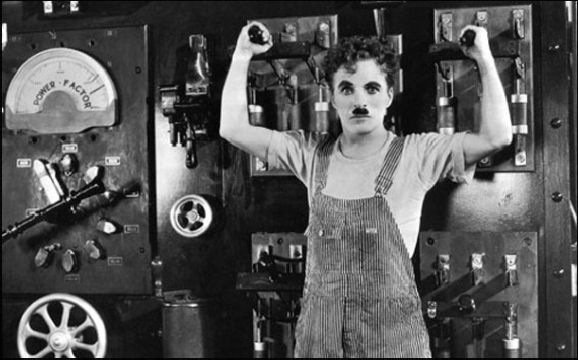Modern Times (1936) 
“Laugh . . . Cry and Thrill To his Genius . . !”

Director: Charles Chaplin
Cast: Charles Chaplin, Paulette Goddard, Henry Bergman
Synopsis: The Tramp struggles to live in modern industrial society with the help of a young homeless woman.
1936 – nine years after the introduction of talking pictures and yet Chaplin continued to resist its intrusion into his work. The barriers were crumbling, however, and Modern Times would be his last silent movie. In truth, it isn’t a silent movie at all, as dialogue and sound effects are included on the soundtrack, but Chaplin’s dislike for sound – particularly as he felt his Little Tramp character simply wouldn’t work if he spoke – meant that the only person who speaks is the Big Brother-like business mogul who spies on his workforce on a bank of TV screens on the wall of his plush office. The intimation is clear: the advent of sound in motion pictures is just another example of the technology that Chaplin felt had a dehumanising impact on the common man.
Chaplin’s Little Tramp – described as The Factory Worker in the credits – is gainfully employed as Modern Time begins, toiling on a fast-moving production line which effectively enslaves the workforce operating on it. His job is to tighten bolts with a couple of spanners before the unit moves on to the next worker in line, but the line moves so swiftly that merely stopping to bat away an annoying fly is enough to throw the entire process into turmoil. The scenes are very similar to scenes from A nous la liberte, a French movie made six years earlier. In fact, Chaplin’s scenes are so similar that Tobis, the first film’s German production company took a lawsuit out against Chaplin, who denied ever having seen their film.
Either way, it’s an inspired and very funny sequence which opens the way for a series of episodes detailing the increasing intrusion of modern technology on every aspect of the common man’s life, even if that man himself has no understanding or use for the technology in question. Chaplin’s Tramp is himself a faulty cog whose interaction with the system causes it to malfunction. Out of work after suffering a breakdown following a spell on the conveyor belt which saw him literally swallowed up by the machinery he was operating, Chaplin falls in with The Gamin, a feisty young orphan played by the gorgeous Paulette Goddard and this odd couple set off, in their own eccentric way, in pursuit of the American Dream. The road is paved with difficulties, and ultimately the couple fails in their aspirations. But at the heart of Modern Times, as with most of Chaplin’s movies, is an unshakable belief in the durability of the human spirit, something which no amount of modern technology will quell. The location of the final scene of the final Little Tramp movie is as far removed from that technology as it is possible to get on this planet, and is arguably the single most blissful scene of Chaplin’s career.
Modern Times marked the last time that Chaplin would don the little tramp’s outfit on screen. Given the iconic – and poignant – nature of that final scene in which the tramp and his soulmate optimistically stroll down a dusty road towards an uncertain – but sunny – future, one can’t help thinking that Chaplin himself already half-suspected that the Little Tramp’s time in the spotlight had drawn to a close. Given the pleasure his character had given generations of viewers it was perhaps only fitting that he should be allowed to head off into the sunset with the girl.
(Reviewed 12th July 2013)
httpv://www.youtube.com/watch?v=Ekwbgtp1_Vg
